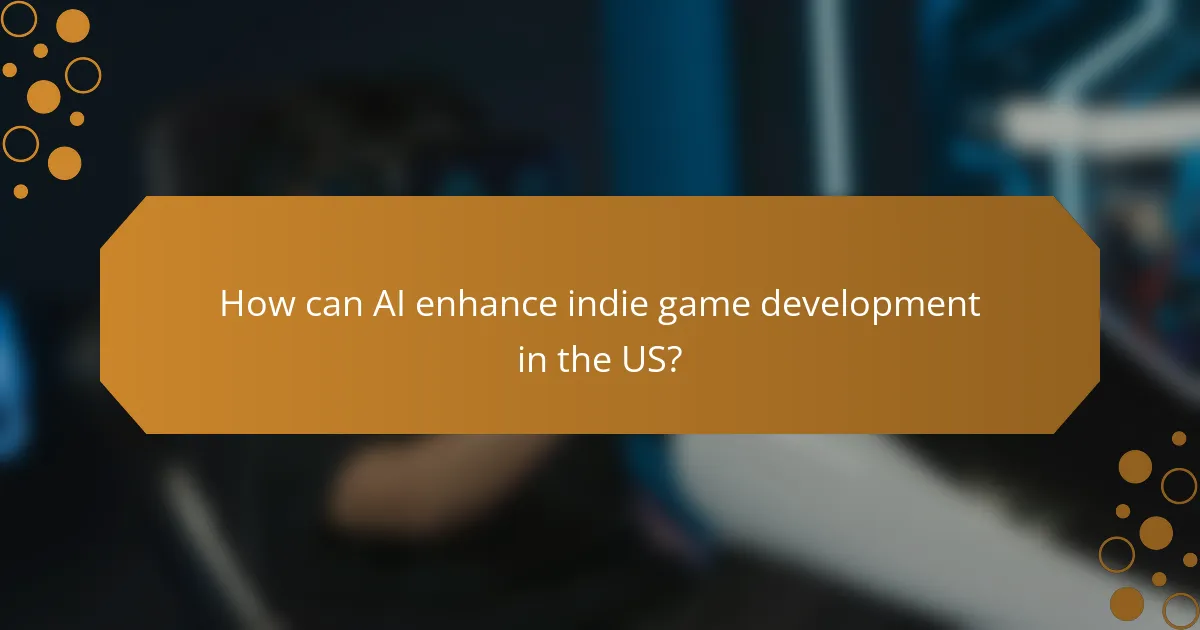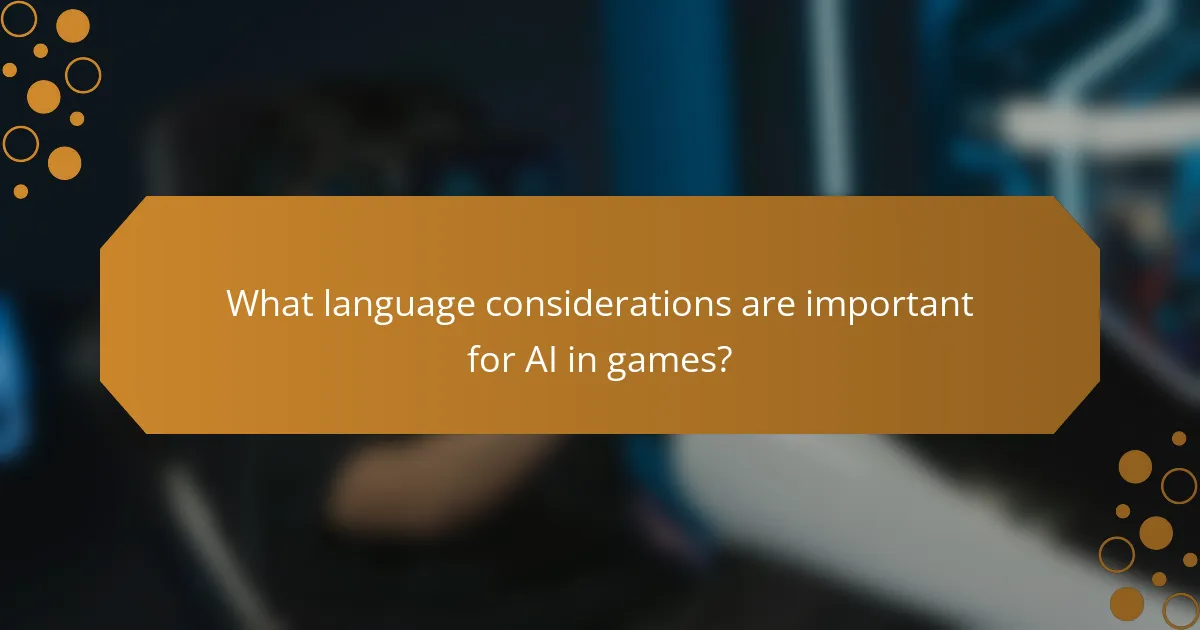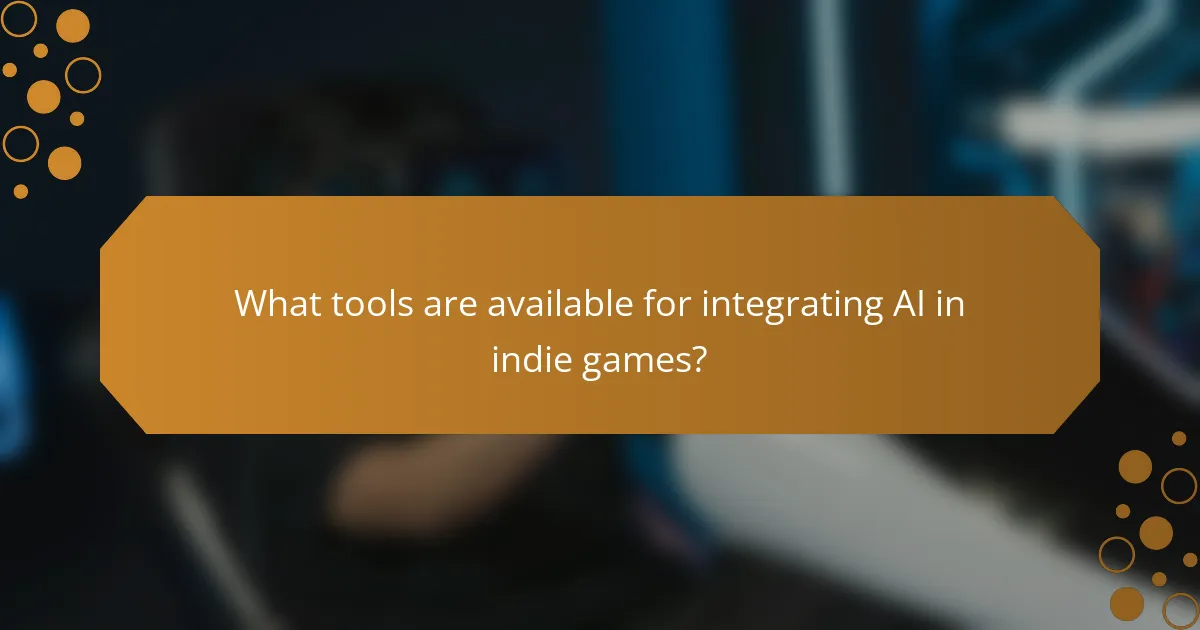Integrating AI into indie games presents a transformative opportunity for developers, enhancing gameplay and streamlining production processes. By leveraging AI technologies, indie creators can not only improve player engagement but also tackle language considerations such as localization and cultural context, ultimately crafting more immersive experiences. This approach not only optimizes resources but also allows for unique gameplay innovations that resonate with diverse audiences.

How can AI enhance indie game development in the US?
AI can significantly enhance indie game development in the US by streamlining processes, improving player engagement, and enabling unique gameplay experiences. By integrating AI technologies, indie developers can create more immersive worlds while optimizing resource use and reducing development time.
Automated content generation
Automated content generation allows indie developers to create vast amounts of game assets quickly and efficiently. This can include everything from procedural level design to generating dialogue and quests, which can save time and reduce costs. For instance, using AI tools, developers can create unique environments or character backstories with minimal manual input.
However, it’s essential to maintain quality control over AI-generated content. Developers should regularly review and refine generated assets to ensure they align with the game’s vision and narrative. Balancing automation with creative oversight is key to achieving the best results.
Dynamic storytelling
Dynamic storytelling leverages AI to adapt narratives based on player choices and behaviors, creating a more personalized gaming experience. This approach can lead to multiple endings or story arcs, enhancing replayability and player investment. For example, an AI system could analyze player decisions and adjust the plot accordingly, making each playthrough unique.
To implement dynamic storytelling effectively, developers should define key decision points and potential story branches in advance. This planning helps ensure that AI adaptations remain coherent and engaging, avoiding disjointed narratives that could frustrate players.
Player behavior analysis
Player behavior analysis involves using AI to track and interpret player actions, providing insights into preferences and gameplay patterns. This data can inform game design decisions, helping developers refine mechanics and improve user engagement. For instance, understanding which levels players struggle with can lead to targeted adjustments that enhance overall enjoyment.
Indie developers should consider incorporating analytics tools that offer real-time feedback on player interactions. Regularly reviewing this data can help identify trends and areas for improvement, ensuring the game evolves in response to its audience’s needs. However, it’s crucial to respect player privacy and comply with relevant data protection regulations.

What are the benefits of using AI in indie games?
Integrating AI in indie games offers significant advantages, including cost efficiency, improved player engagement, and enhanced game testing. These benefits help indie developers create more immersive experiences while optimizing resources.
Cost efficiency
AI can significantly reduce development costs for indie games by automating repetitive tasks such as asset creation, level design, and even coding. This allows small teams to focus on creative aspects rather than getting bogged down in technical details.
For instance, procedural generation techniques powered by AI can create vast game worlds without requiring extensive manual input, saving both time and money. This can be particularly beneficial for indie developers working with limited budgets, enabling them to allocate resources more effectively.
Improved player engagement
AI enhances player engagement by personalizing gaming experiences based on individual player behavior and preferences. By analyzing player data, AI can adjust difficulty levels, suggest in-game content, and tailor narratives to keep players invested.
For example, AI-driven NPCs (non-player characters) can adapt their responses and actions based on player choices, creating a more dynamic and immersive environment. This level of interactivity can lead to higher player retention rates and increased word-of-mouth promotion.
Enhanced game testing
AI can streamline the game testing process by identifying bugs and gameplay issues more efficiently than traditional methods. Automated testing tools can simulate various player behaviors, uncovering potential problems that might be missed during manual testing.
Utilizing AI for testing can reduce the time spent on quality assurance, allowing developers to focus on refining gameplay and enhancing user experience. This is particularly valuable for indie developers who may not have extensive QA resources at their disposal.

What language considerations are important for AI in games?
When integrating AI in indie games, key language considerations include natural language processing, localization challenges, and cultural context adaptation. These factors significantly influence player experience and engagement, making it essential to address them effectively.
Natural language processing
Natural language processing (NLP) enables AI to understand and generate human language, enhancing player interactions. For instance, AI-driven chatbots can provide real-time assistance or narrative dialogue, making gameplay more immersive. Developers should focus on training models with diverse language datasets to improve accuracy and responsiveness.
Consider implementing NLP tools that can handle multiple languages and dialects, especially if targeting a global audience. This approach not only broadens accessibility but also enriches the gaming experience by catering to various linguistic preferences.
Localization challenges
Localization involves adapting game content to different languages and cultures, which can be complex. It requires not only translating text but also modifying graphics, audio, and gameplay elements to resonate with local audiences. For example, idiomatic expressions may need to be replaced with culturally relevant equivalents.
Indie developers should prioritize localization early in the development process. Utilizing localization management tools can streamline workflows and ensure consistency across different language versions. Additionally, engaging native speakers for review can help avoid common pitfalls in translation accuracy.
Cultural context adaptation
Cultural context adaptation ensures that game narratives and mechanics align with the values and norms of target audiences. This may involve altering storylines, character designs, or gameplay mechanics to avoid cultural insensitivity. For example, certain symbols or themes may be interpreted differently across cultures.
To effectively adapt to cultural contexts, conduct thorough research on the target demographics. Collaborating with local experts or cultural consultants can provide valuable insights and help create a more authentic gaming experience. Regular feedback from players in different regions can also guide ongoing improvements.

What tools are available for integrating AI in indie games?
Indie game developers have access to several powerful tools for integrating AI, each offering unique features and capabilities. Popular options include Unity ML-Agents, OpenAI’s GPT-3, and IBM Watson, which cater to different aspects of game development such as machine learning, natural language processing, and player interaction.
Unity ML-Agents
Unity ML-Agents is a toolkit that enables developers to integrate machine learning into their games using the Unity engine. It allows for the training of intelligent agents through reinforcement learning, making it ideal for creating adaptive NPC behaviors and dynamic game environments.
To get started, developers need to install the Unity ML-Agents package and set up their game environment for training. A common approach is to define the agent’s observations, actions, and rewards, which guide the learning process. This can lead to more engaging gameplay, as NPCs can learn and adapt to player strategies over time.
OpenAI’s GPT-3
OpenAI’s GPT-3 is a state-of-the-art language model that can generate human-like text, making it useful for creating dialogue systems and narrative content in games. By integrating GPT-3, developers can provide players with rich, interactive storytelling experiences and responsive character interactions.
To implement GPT-3, developers typically use the OpenAI API, which requires an API key and adherence to usage guidelines. It’s important to manage the balance between scripted dialogue and AI-generated responses to maintain coherence and avoid disjointed conversations.
IBM Watson
IBM Watson offers a suite of AI services that can enhance indie games through natural language processing, machine learning, and data analysis. Features like Watson Assistant can be used to create chatbots that interact with players, while Watson Discovery can analyze player feedback to improve game design.
Integrating IBM Watson involves setting up an account and utilizing its APIs for specific functionalities. Developers should consider the cost associated with API calls and the need for a stable internet connection for real-time interactions. Properly leveraging Watson’s capabilities can lead to more personalized player experiences and better game insights.

What are the prerequisites for implementing AI in indie games?
To successfully implement AI in indie games, developers need a blend of technical skills and an understanding of game design principles. These prerequisites ensure that AI enhances gameplay rather than complicating it.
Technical skills in AI
Developers should have a foundational knowledge of programming languages commonly used in game development, such as C# or Python. Familiarity with AI frameworks and libraries, like TensorFlow or Unity ML-Agents, can significantly streamline the integration process.
Understanding algorithms related to pathfinding, decision-making, and machine learning is crucial. For instance, implementing A* for navigation or using neural networks for adaptive gameplay can elevate the player experience.
Understanding of game design
A solid grasp of game design principles is essential for effectively integrating AI. This includes knowledge of player engagement, balance, and the overall game mechanics. AI should enhance these elements rather than disrupt them.
Consider how AI can create dynamic environments or responsive NPCs that adapt to player actions. For example, using AI to adjust difficulty based on player performance can maintain challenge without causing frustration.

How does AI impact player experience in indie games?
AI significantly enhances player experience in indie games by creating dynamic and responsive environments that adapt to individual player behaviors. This personalization fosters deeper engagement, making gameplay more immersive and enjoyable.
Personalized gameplay
Personalized gameplay leverages AI to tailor experiences based on player choices, preferences, and skill levels. By analyzing player data, AI can adjust game difficulty, suggest content, or modify storylines to better suit individual players.
For instance, an AI-driven system might track how often a player fails at a particular level and subsequently lower the difficulty or provide hints. This approach not only keeps players motivated but also encourages them to explore different aspects of the game without feeling overwhelmed.
When implementing personalized gameplay, developers should consider balancing player autonomy with AI suggestions. Too much guidance can diminish the sense of achievement, while too little may lead to frustration. A good practice is to offer options for players to adjust the level of AI assistance according to their preferences.
